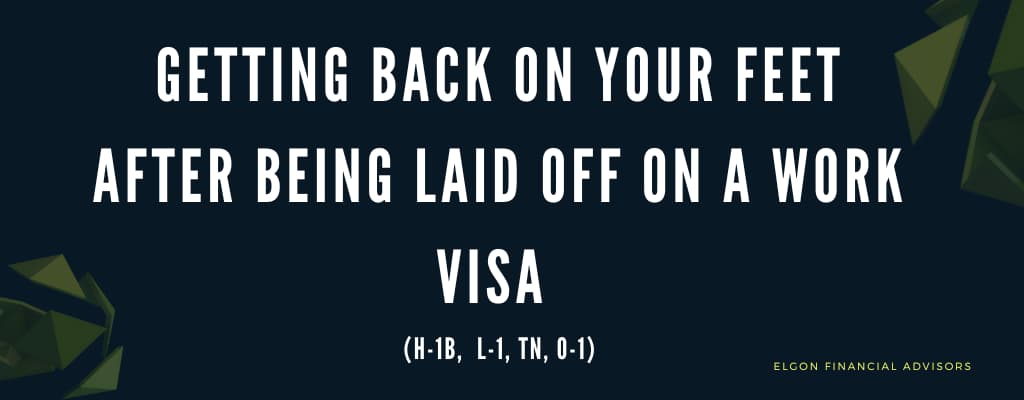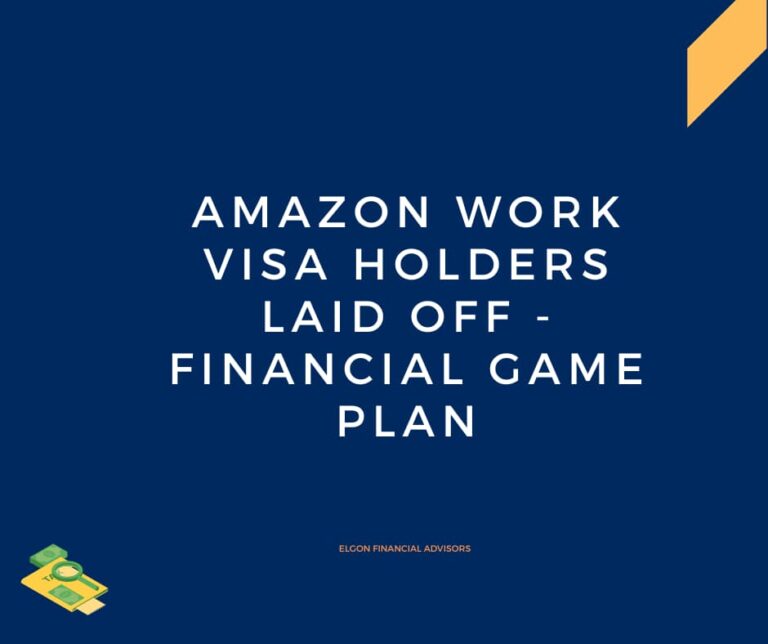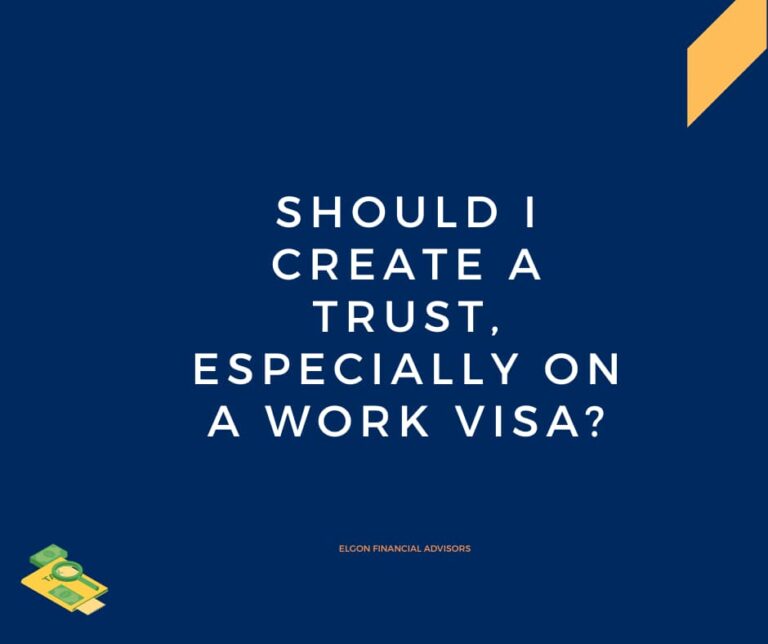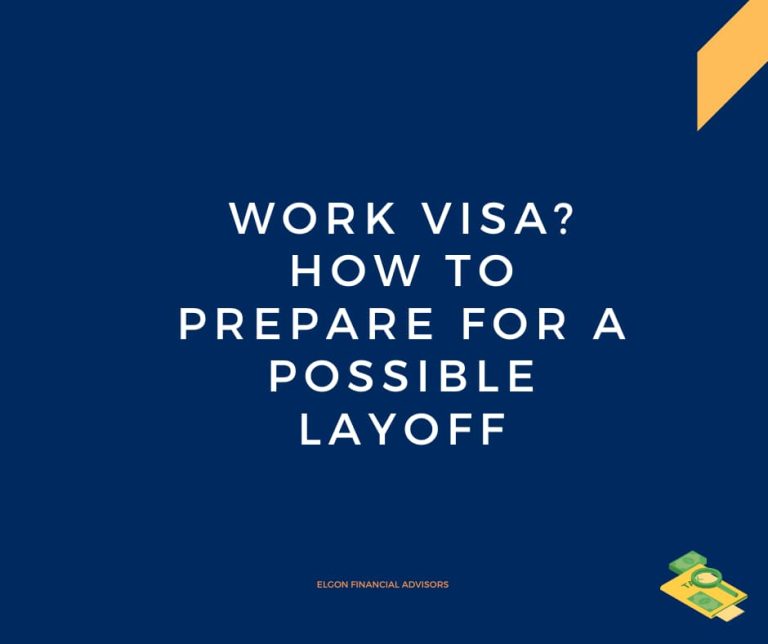Updated 7/1/2025
Being laid off on an H-1B work visa or any other work visa (E-3, TN, L-1, O-1) is a huge and real concern for foreign-born tech workers.
My biggest job fear when I initially got into the tech industry on an H-1B visa was that I could be laid off at any moment.
This had nothing to do with my performance, but I was keenly aware of the at-will thing between an employee and an employer.
I knew I could always find another job, but the question was how quickly could I find that job?
And could I get an employer willing to work on my schedule?
I’m seeing the same story being repeated day after day, as foreign workers scramble to find new jobs with the current layoffs.
More stories on tech companies letting go of workers, which include foreign nationals on work visas.
Microsoft lays off 9000 workers
NetApp Trims Workforce Amid Mixed Market Signals
In this post, I’m addressing what to do if you get laid off and are on an H-1B visa or another work visa, such as an L-1, TN, E-3, or O-1.
In the next post, I’ll address how to prepare for this.
Common Work Visas And Nuances That Apply To Each
Over the next few paragraphs, I’ll share a high-level overview of a couple of different examples of work visas, beyond the H-1B, probably the most widely known visa.
I’ll also include specific actions you can take on each visa to help you get back on your feet if you get laid off or lose your job in another way.
In all this, I highly recommend consulting with an immigration attorney familiar with the laws to determine the best option for you and your family.
The H-1B Visa
The H-1B visa is a nonimmigrant visa that allows US companies to hire foreign workers for certain types of jobs.
It’s one of the few dual-status visas, which means that you can continue being on a nonimmigrant visa while applying to make your status permanent.
The jobs must be in specific specialty areas and require certain skills and education. It’s the most common visa for workers in the tech industry.
At a minimum, you must have a bachelor’s degree, which can be earned either in the US or in your home country. You can apply for the visa in the US or while still in your home country.
Four conditions must be met to obtain an H-1B visa. Please note that the visa is tied to this specific employer.
Technically, you can have two H-1B visas (concurrent visas), but it’s very tough to prove that you can maintain both jobs.
The minimum education you need is a bachelor’s degree.
A job offer from a US company requiring specialized knowledge.
A lack of qualified talent for that role is something the employer needs to demonstrate.
Documentation to prove that the employer is willing to pay the prevailing wage or the actual wage, whichever is higher.
H-1B Visa Lottery
Many companies and employees are applying for the visa, so USCIS conducts a lottery every year to determine who will have the opportunity to apply for that visa.
There are 65,000 visas available each year, with an additional 20,000 reserved for those holding a master’s degree.
This page displays the number of registrations over the past couple of years and the numbers selected through the lottery. For example, in fiscal year 2023, USCIS received 483,927 registrations and ended up selecting 127,000 via a lottery.
Universities, certain government research organizations, and related non-profits are exempt from the cap and can apply for the visa at any time. A possible future planning opportunity.
What To Do If You Get Laid Off On The H-1B Visa?
If you are laid off from your job while on this visa, you must act very quickly. You have about 60 days to find a solution, assuming your I-94 has not expired.
If you have less than 60 days remaining on your I-94, then your 60-day window is reduced to that number.
Your options are as follows.
Get a new job and have your new employer file for a new H-1B visa on your behalf. In this case, you are not under any visa cap.
Leave the country within the 60-day grace period to avoid accruing unlawful presence. Essentially, avoid being in the country illegally. Any unlawful time can be penalized in the future.
Change your visa type. A couple of examples
If your spouse is here on another visa, you can change your status to a dependent visa, such as an H-4 (H-1B), TD (TN), or L2 (L-1) visa.
Change to an F-1 visa and go back to school.
Change to a B-2 visa and become a visitor.
Carefully weigh the implications of each of the above choices. This is best done with the assistance of an immigration lawyer.
This is the one area I highly suggest never attempting to solve on your own.
L-1 Visa
The L-1 visa is a work visa granted to executives and other workers with specialized knowledge transferring from a branch or office overseas to the US.
The visa has no cap limit, and spouses (or dependents) can also work.
The conditions for this visa are: –
Having worked for at least one year for the company over the last 3 years.
Be looking to enter the US to work for that same company or one of its qualifying branches.
What To Do If You Get Laid Off On The L-1 Visa
Like the H-1B visa, you have 60 days to figure out your future before you are out of status. As long as your I-94 is still valid, these are your options.
Find a new job and have the new employer file a petition for you, under a new work visa. You are eligible for the H-1B, TN, or even the E-3 visas.
Transition to a dependent visa L-2.
Switch to another type of visa, like F-1 or B-2.
- Leave the country.
TN Visa
This is a non-immigrant work visa granted to NAFTA members (North American Free Trade Agreement). So basically, citizens from Canada and Mexico.
It’s not dual intent, so a company cannot technically file the green card for you, but there are ways companies handle this.
To obtain a visa, you will need the following.
A firm job offer from an employer in the US.
The job must be in one of the NAFTA-approved occupations.
A citizen of Mexico or Canada, not a permanent resident.
What To Do If You Get Laid Off On The TN Visa
Similar to other visas, you have 60 days, as long as your I-94 is valid, to figure out life.
Find another company that will offer you a job on a TN visa. You can switch to the H-1B visa, but you have to go through the lottery and hope you get picked. If it’s outside of the lottery window, then this may not be a viable option for you.
- If you can apply for one of the non-cap H-1B’s then you have a chance.
Switch to a dependent visa (TD)
Switch to another visa, like F-1 or B-2.
Leave the country (US) before the 60 days are over.
E-3 Visa
The E-3 visa is a specialty work visa granted to Australian citizens.
There is a cap on the number of these that can be issued (the last time I checked, it was 10,500), and spouses (or dependents) can also be eligible to work.
The conditions for this visa are: –
Speciality occupation.
Bachelor’s degree, and a job offer in the US.
Australian citizen.
Plan to leave at the end of your assignment
What To Do If You Get Laid Off On The E-3 Visa
Like the H-1B visa, you have 60 days to figure out your future before you are out of status. As long as your I-94 is still valid, these are your options.
Find a new job and have the new employer file a petition for you, under a new work visa. You are eligible for the H-1B or another E-3 visa.
Transition to a dependent visa E-3D.
Switch to another type of visa, like F-1 or B-2.
- Leave the country.
O-1 Visa
The O-1 visa is granted to individuals with extraordinary abilities in various fields, including arts, science, business, and athletics. It’s pretty tough to get this visa, due to the amount of evidence required to prove your extraordinary ability.
You can work for two employers, but each must file its petition, giving you two O visas.
It’s also a dual intent visa, meaning you can apply for permanent citizenship (green card) without issues.
Unlike the H-1B visa, it has no caps.
What To Do If You Get Laid Off On The O-1 Visa
If you lose your job through no fault of your own, you have one advantage over folks on other work visas.
The employer is obligated to pay for your transport back to your last place of residence before entering the US. Other options include:-
Finding a new job on the same visa, or a different visa, like H-1B.
Switching to a dependent visa.
- Switching to another visa, like F-1 or B-1.
- Leaving the US.
If your country has an investor treaty with the US, the E-2 investor visa is a possibility with all the above visas. You’ll need a good amount of money and a sponsor involved in the specific trade.
The law does not have a minimum amount of money to be invested.
Most lawyers recommend around $100,000, though it depends on the type of business you are creating.
Dealing With Finances When You Are Laid Off On A Work Visa
It sucks to lose your job, especially when you are not prepared, but it’s even worse when you are on a work visa.
Much of the worry could be alleviated by making early preparations and being intentional about various aspects. For this post, we’ll assume you didn’t.
Our jobs are a big part of our identity, and losing that does lead to a void and grief. Typically, we’d advise you to take the time to mourn and grieve that loss.
Unfortunately, being on a work visa means you have very little time to dwell on that, which adds to the stress level. My advice on this is to be super strong and focus on the next step.
It may sound harsh, but things can worsen unless you take action first. My goal is to help you be in control of the situation.
I’ve been on an H-1B visa, and I understand the gut-wrenching, churning fear that comes with any discussion of layoffs.
If it means being on autopilot for the next 30-60 days, it’s okay.
Day 0 To Day 10 – ASAP Steps
Three things you want to do ASAP.
Check to see your 1-94 validity. The 60-day grace period assumes you have this much time remaining. If it is no longer valid, you’ll have a 10-day grace period to leave the country or find another job.
Consult with an immigration lawyer and discuss your options, preferably one who is not affiliated with the company.
Update your resume and start networking. The key is to be persistent, but not to come across as overly eager or desperate.
Get your resume to everybody who has a connection in the industry.
Update your LinkedIn profile to indicate you are searching for a new job. Post that you are looking for a new job, and let people know that you only have a limited amount of time to secure a new one.
Don’t forget to check internal postings at your former employer.
If your spouse is on a dependent visa and there is a remote chance they could obtain a work visa, seriously consider having them start looking as well.
If one of you gets a job, then you both have a chance to go on with your lives.
Day 11 To Day 20 – Go Into Emergency Mode
The next step is to figure out your exact financial situation. Hopefully, you have a budget, and you know how much you need to run your life.
Put on hold any big-ticket items, anything that would be considered a want at this point.
Sadly, you might also have to price air tickets back home.
Day 21 To Day 40 – Practical, Practical, Practical
If you have older kids in school, this option will not work for you. It also has to be right for your family, assuming they are on a dependent visa.
You may consider sending your family back home if it makes sense and if it will help you focus on your job search. It has to make economic sense for you.
Step up the search for a new job.
Day 41 To Day 60 – Don’t Give Up
Hopefully, by now, you have a game plan in place. If you get a new job, and the employer starts the new visa process, you can sit back and relax.
You are not allowed to work until the petition is approved, but this is something you should confirm with your immigration lawyer.
Health Insurance
The worst thing that can happen is to lose your insurance coverage and then face a medical emergency.
You may not be eligible for Cobra coverage, and/or ACA-type of plans.
A couple of options to consider.
Partner’s Insurance
This is probably the easiest option. If your partner is working, you may be able to claim a life-changing event, allowing you to get on your partner’s insurance.
Short-Term Health Insurance Plan
This will cover you for a short period, typically up to a year. They are a temporary insurance solution while you figure out a more permanent solution.
Travel Plan Health Insurance
Travel insurance is another option for coverage. A good example is Visitors Coverage, which is a company that offers travel insurance.
In this post, I outline steps you can take ahead of time to prepare for a possible layoff on a work visa.
I’m not a lawyer, but I work with immigration lawyers in this space.
I’ll emphasize this again: it’s crucial to work with an immigration lawyer whenever you are considering a change in visa status.
Need Help Figuring Out the US Financial Landscape?
Free Financial Assessment
If not ready to start, that’s okay, but please stay on top of our regular updates by email, or by joining here. Sign Up Here.
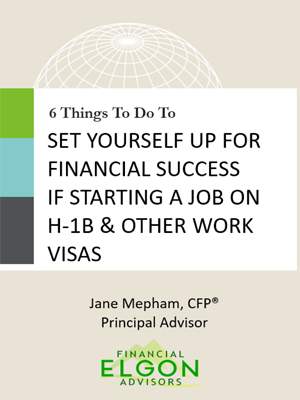
6 Things to Do
When Starting A Job on H-1B Visa
You are starting a new job on a work visa, there are some critical things, that will set up for financial success in the first 3-6 months. Download the free guide below for the detailed list!
We never spam. By signing up you’ll also receive access to future resources right to your inbox.
Disclaimer: This article is provided for general information and illustration purposes only. Nothing contained in the material constitutes tax advice, a recommendation for the purchase or sale of any security, investment advisory services, or legal advice. I encourage you to consult a financial planner, accountant, and/or legal counsel for advice specific to your situation. Reproduction of this material is prohibited without written permission from Jane Mepham and all rights are reserved. Read the full disclaimer here.



